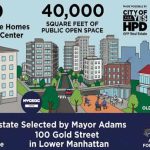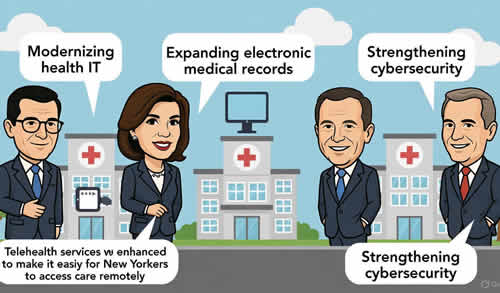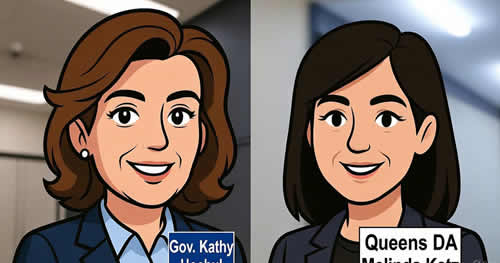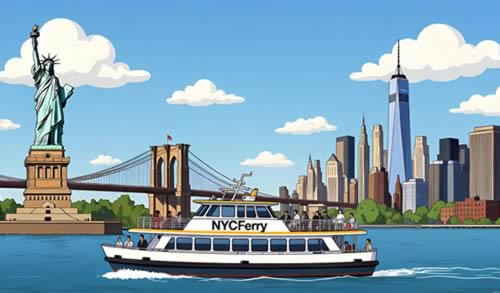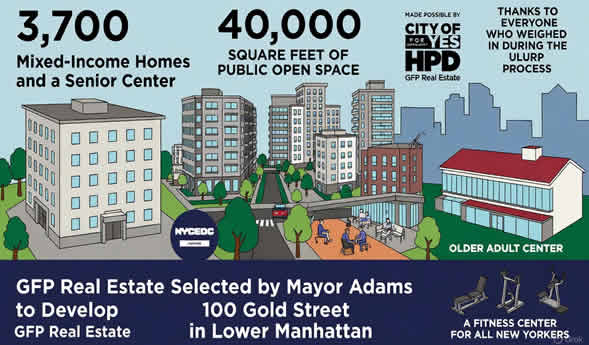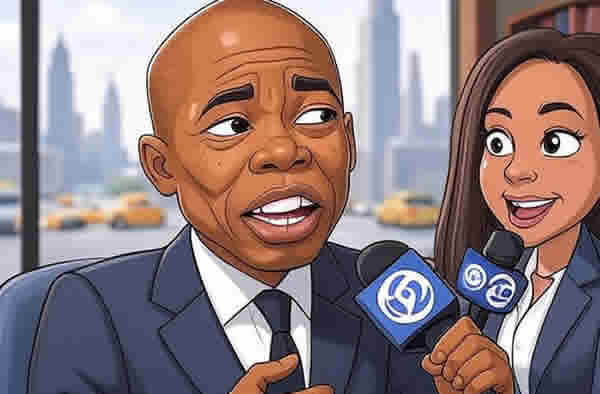
New York City Mayor Eric Adams joined News12’s “Ask the Mayor” segment to discuss pressing issues, including a recent surge in gun violence, school safety, and affordable housing. Addressing a series of shootings in the Bronx and Brooklyn, Adams outlined a full mobilization plan targeting hotspots, gang activity, and repeat offenders, with a focus on community-based crisis management teams. He emphasized proactive measures, such as job training programs for justice-involved individuals to curb crime. On school safety, Adams highlighted the new cell phone ban in schools to reduce distractions and violence, alongside enhanced security measures like camera systems and roving metal detectors. Responding to a caller’s concern about crime in the Bronx, he committed to exploring additional NYPD cameras for high-risk areas. Adams also discussed housing initiatives, noting efforts to increase affordable housing stock through rezoning and projects like Willets Point. On autonomous vehicles, he clarified that testing aims to enhance accessibility without displacing taxi drivers. Addressing the Bally’s Casino proposal, Adams defended his veto to allow Bronx residents a voice in the decision-making process, emphasizing fairness and opportunity.
Transcript: Mayor Adams Participates in Live Interview on NEWS12 and Takes Questions From New Yorkers
Amanda Bossard: Hello, everyone, and thanks for being with us here on News12, where local matters. I’m Amanda Bossard, and this is Ask the Mayor. It is a pleasure to be back here with you for the next half hour, as we give you the opportunity to ask New York City Mayor Eric Adams your questions right here on the air.
So the number to dial is 718-861-6800, and it will be at the bottom of your screen throughout the program for reference. With that, we’d like to welcome back once again tonight to our studios, New York City Mayor Eric Adams. Always a pleasure to have you with us.
Mayor Eric Adams: Great to be here. Enjoy this time of day, [on] this day of the month, to come around and talk.
Bossard: A great opportunity to answer those questions directly from New Yorkers. I’ll kick off the conversation, though, unfortunately, on a somber note this evening, and talk about this recent spree of violence, specifically gun violence, that we’ve seen in just the short time since we last spoke with you.
We’ve seen a mass shooting in Midtown claim the life of a Bronx officer, another mass shooting where fourteen people were shot inside of a Crown Heights lounge, and then this past weekend in the Bronx specifically, back to back to back shootings, a multiple shooting unfolding in the Bronx as recently as today.
I know in response to this recent violence, you have said that in the Bronx specifically to address gangs and younger shooters that we’re seeing, you’ve issued a full mobilization plan directive to the chief here in the borough. What do you expect to be part of that plan, and how soon do you expect to see it being implemented to immediately address this violence we’re seeing?
Mayor Adams: It is extremely unfortunate. When you see the good work we have done on removing the illegal guns off our streets, and what the police commissioner has done in identifying hotspots, and when you look at these large number of shootings out of one incident, fourteen people in Brooklyn in a night club, four in the Bronx over the weekend, it just really hurts all of the efforts that were put in place.
And there’s a common denominator we’re seeing over and over again. Young shooters, gang involvement, repeated offenders. That repeated offenders that we talked about on some of our laws, that’s just, you know, we are seeing repeated offenders.
So what we’re going to do– the commissioner is going to make sure that we have the attention in the Bronx, looking after the hotspots, knowing some of the known gang members, using our crisis management team members, because they are the best at dealing with retaliatory shootings.
We know how well they do. And so the team must zero in, identify what is causing this uptick in gun violence that we’re seeing. And we have to respond. And the commissioner has done a good job in doing so for the last seven months with the lowest number of shooters and shooting victims. And we have to make sure we continue the implementation of the plan and continue to drive down gun violence.
Bossard: You spoke specifically about how young people are getting caught up in the gun violence, and we’re seeing that number sadly rise, despite other statistics on the decline. We have school a little bit more than a week away at this point.
What efforts are in place right now to ensure that this street violence doesn’t seep into our classrooms, especially as families now navigate this new normal with the cell phone ban? I’m sure parents are concerned about not having such easy access to their kids while they’re in class.
Mayor Adams: And I’m glad you asked that because, believe it or not, cell phones contribute to violence. And that is why the goal was to remove cell phones from schools. This is going to be the first year that it’s going to be actually done. The governor, kudos to her, for partnering with the lawmakers in Albany to state that we have to take the cell phones out of the school. They’re distractions, they’re used for bullying, they’re used to start fights with children.
And really, it’s just not the place for our children. Many have tried. We wanted to take our time and make sure we got it right. And that’s exactly why it took this long. Because we have to get it right. We don’t want to start and then turn back.
But to those parents that are concerned about notifications when something happened, like what happened today, where a mad gunman went in and shot innocent babies, they want to be notified. And so we have to be using state-of-the-art technology, communication methods, so when something does happen, we can immediately let families know what we’re dealing with and if a child is in harm’s way.
Bossard: You mentioned this active shooting situation that we saw unfold earlier today at a Minneapolis Catholic school where two children, sadly, were lost in that situation. Of course, people fear the worst could happen here at home.
In terms of specific security safeguards, should we expect to see more metal detectors? Any other extra efforts in light of the violence that we’re seeing with schools so closely approaching?
Mayor Adams: Good question. First of all, many of our schools, we probably did all by now, but many of our schools, when you come to the school, [there’s] no more just [opening] doors. There is a camera with a bell. The school safety agent must buzz you in. So that’s an important mechanism that we put in. That was the first time this has ever been done.
If we didn’t do all the schools, I know we’re in the process of doing so to make sure that anyone cannot just wander into the school building. We do roving metal detectors and checks using metal detectors based on the circumstances. Some of them are surprise metal detectors that come into the school. They are able to move around.
We have been looking at more technology because it’s getting better and better and better. That is our goal to use technology to make sure we keep our city safe. And we’re going to continue to focus on that.
We have a great team of school safety agents. There’s going to be some movement with the school safety division that the commissioner is going to be announcing, but it’s all about making sure we create a safe environment on our school campuses.
Bossard: And then when we expand this conversation surrounding safety at the national level, we’ve heard from President Donald Trump as of late saying that he’s considering sending the National Guard to New York City. You’ve said that’s not needed.
Other members of your administration have echoed that sentiment with the violence we’ve seen as of late. Why say we don’t need the National Guard right now? Why not welcome that help?
Mayor Adams: Because you don’t– Because the National Guard would send the wrong message, number one, a visible uniform presence in New York City, it could impact business. It could impact the entire perception of our city. The numbers are in the right direction with the decrease in crime, our seven major crime categories, what we’re doing. [What] the Police Department is doing already and taking guns off our street. And just think about it.
Our subway system with 4.6 million riders is only five average felonies a day with 4.6 million people. So it’s the safest that it has been in decades when you take [out the] two years of COVID. So we know how to do it here in the city. And if we need to help other cities, if the president or White House determines they would like to see some of the things we’re doing, we’re more than willing to do so.
But we also coordinate with our federal, state, and city partners every day at 10 a.m. in the morning. We meet in something called HIDTA. We go after trigger pullers. We go after shooters. We go after those who are known to carry guns. So we are coordinating already.
The real need of the federal government, we have to stop the flow of guns in our cities. When you have a person that has an AR-15, drives across the country and shoots four innocent people and himself, that is what our focus point must be. We have to stop this fixation with guns like what we saw happen in another state.
Bossard: Yeah, and a lot of pressure being applied to those federal lawmakers to act on that now more than ever. I do want to get to our first caller of the evening. We have Noel who’s called in from Soundview. Thanks so much for the call, Noel. And what’s your question for the mayor this evening?
Question: Yes, good evening, Mayor Adams.
Mayor Adams: Good evening.
Question: My question for today is about the crime that’s going on in our borough, the Bronx. You know, it’s kind of concerning, you know, and it’s just, I was wondering to see what– how can we fix that? How can we address that much better?
It’s kind of scary to even go outside to go to the store when someone’s getting robbed. You can’t wear any jewelry, you can’t wear– you have to be actually keeping your head on a swivel. And it’s scary.
Mayor Adams: Well said, Noel. And we don’t want you living that way in our city where you are afraid just to enjoy the beauty of the city. I hear over and over again from people, they hear about these terrible incidents, but they say, “Eric, I feel safer walking the streets, I feel safer going out in my parks at night.”
What we’re seeing in the city, we have really dealt with the issue of crime in the city. And when you do– there’s always this bar graph [that shows] how crimes are in big cities. We’re the safest big city in America. Safest in America. The largest in America. Very complex.
But we have a Police Department that is second to none. And they’re doing a good job. And Noel, we must make sure that, I like to say, that we have to be reactive to go after those crimes, but we have to be proactive. And what does proactive action mean?
What we did today, we just announced justice-involved people are now able to get free training for their CDL and tractor trailer driving. It is a job that pays between $74,000 to $124,000 a year. No high school diploma needed. We’re going to be training three hundred more. That is how you prevent crime, by having people have the employment they deserve.
Bossard: Yeah, and this opportunity that’s being created to hopefully stop that cycle of violence, like you mentioned, repeat offenders being one of the big issues right now and trying to stem that. Well, the conversation is just getting started here on Ask the Mayor tonight. 718-861-6800 is the number to dial if you have a question. Call in right now. We’ll be right back right after this.
[Commercial Break.]
Bossard: Welcome back to another edition of Ask the Mayor here on News12 with New York City Mayor Eric Adams. As we continue the conversation with our callers right now, we have Sidney who’s on the line. He’s called in from [inaudible] tonight. Sidney, thank you for calling and what’s your question for the mayor?
Question: Good evening, Mr. Mayor.
Mayor Adams: Good evening.
Question: Mr. Mayor, we had a shooting this morning on College Avenue. We had three people shot around 8:30 this morning, College Avenue, 170. And I have asked in the past, [where] I live– I’m a resident here, if we could get a NYPD camera. I asked the previous borough president and I asked Ms. Gibson and nothing, nothing has happened yet.
I’ve spoken to detectives on the 44 precinct. They agree with me and they told me they even have mentioned it, but it’s up to the politicians to allocate the money. And I understand that. And I also understand that Ms. Gibson gave $1.2 or $1.1 million for cameras, for sanitation and police. And I’m hoping maybe you could pick up the phone tomorrow and let her know, please give College Avenue that well-needed NYPD camera at the intersection of College Avenue.
Mayor Adams: Is College Avenue and what, what is the cross street?
Question: It’s between College Avenue, it’s right on College Avenue, East 170 Street, the intersection.
Mayor Adams: Okay. Okay. Let me look into it. Let’s find out from Chief Gurley, who’s here in the Bronx and let us find out exactly how we can move it forward if [there’s] a need for it. Okay.
Bossard: Mr. Mayor, I’ll ask, what is the determining factor for where those resources are placed?
Mayor Adams: Because you’re talking about making sure that you deploy it correctly. If there are issues of violence there, if there are issues such as a shooting like this, if there’s a known gang activity. And so you want to make sure it’s where it is needed, like that is how you deploy the resources correctly. And so they’ll do an analysis to determine where you want to deploy these cameras.
Bossard: So Sidney, thank you for the followup. It’s now on the mayor’s radar for sure. Let’s get to another caller that we have on the line. I believe Anika has dialed in from Co-op City. Thanks so much for the call tonight, Anika. And what’s your question for the mayor when you’re ready?
Question: Yes, my question is, when the years to come, would it be a change with affordable housing and supportive housing?
Mayor Adams: Tell me more about that, Anika. I want to understand your question.
Question: [Inaudible.]
Bossard: I think she’s breaking up a little bit, unfortunately.
Mayor Adams: Okay. You broke up, Anika, but I think I got the gist of it. When you talk– when we talk about housing in the city, we have rent stabilized. We have our affordable housing, a stock of– when people want to build higher, we are able to do zoning changes and we’re able to leverage the number of units that are going to be affordable. It could be anywhere from 20 percent, 30 percent, in some cases, 50 percent.
And like our Willets Point project, it is 100 percent affordable, 2,400 units. Here’s what we were having our problem. We were seeing that it’s an inventory issue. When you have only 1.4 percent vacancy, you could build units, but the demand is so high.
So like in the Bronx, for example, you could have a 500 unit building. But if you have 14,000 people trying to get those 500 units because we haven’t built enough, that’s the problem. That’s why we continue to put shovels in the ground. We have preserved, created, and zoned for over 426,000 units of housing in the next decade throughout [the] City of Yes.
We did five neighborhood rezoning with 50,000 units of housing. We just did a major rezoning in Manhattan where you get 10,000 units of housing. We just did Fordham South where we’re going to do several hundred units of housing, just creating new communities.
And so we have to build more. And that’s what this administration, what we have done so that we can make sure that we have the inventory. Because the inventory is low, then the price goes up.
Bossard: The supply and demand equation, right?
Mayor Adams: There you are. So now for the first time through our City of Yes, we’re going to be developing all over the city. Not over developing communities, but just enough to say that we can all share the responsibility of housing.
Bossard: Housing, a perennial topic that comes up, especially the need for more affordable housing from our viewers. So good to see work continues on that front. When we talk about keeping up with the times, one of the most recent announcements coming from you is these new driverless cars that we’re going to see piloted in some parts of the city, specifically downtown Brooklyn and parts of Manhattan.
I think the big question coming from a lot of people [is], how do you regulate autonomous vehicles? And of course, keep things safe for those who are inside of the vehicle and everyone outside in a city as busy as New York.
Mayor Adams: People automatically jump to the conclusion that, okay, we’re going to have these for taxis. That is not true. We want our men and women who are taxi drivers to continue to be taxi drivers. It’s good employment, the hardworking men and women, and we believe that is a good middle class income.
We’re testing out the technology and that technology can be used in many ways. And we’re testing the technology, driverless vehicles, they are here. We need to make sure that we’re not displacing employees, but at the same time, we should use the technology to be a benefit.
Let’s say a person who, for whatever reason, is visually impaired and they want to just be able to have control of their lives and not be restricted. So this technology can be used appropriately and we’re looking forward [to it] on our city streets. These are some of the most complicated streets to drive on.
Bossard: If you can navigate New York City, you’re pretty safe to make it anywhere else in this country, at least by my opinion here. In terms of safety, we are confident that the technology is going to keep that in mind as well.
Mayor Adams: A lot of tests. When I was in– I believe, when I was in the borough president’s office, it was the first time I found out about Waymo. So it’s safe technology.
Bossard: All right. Great to hear and very reassuring for a lot of people watching. More conversation right on the other side of this quick break. Stay with us here on News12.
[Commercial Break.]
Bossard: Thanks for staying with us here on News12 for this edition of Ask the Mayor with New York City Mayor Eric Adams. Last time you were with us, Mr. Mayor, we were talking about the Bally’s Casino proposal in the Bronx specifically, and since then, you have issued a veto to the City Council’s decision to pretty much halt that proposal from being able to move forward.
Your veto would allow it to continue to be considered by the state. What was your motivation behind that decision, considering that people in the area say, we don’t want this here, and what is your response to the council saying, well, we plan to override that.
Mayor Adams: And they have a right to. They have a right to override the veto. What I was saying is that I’m not for or against any of the projects, and we don’t make the ultimate decision anyway, but why do we deny the Bronx all the time? Why is the Bronx the place where we say always no? I said this is a City of Yes, and the Bronx is part of that City of Yes, and many Bronx electeds supported having an opportunity to discuss and put Bally’s as one of the places that is being considered, and they should have the right to do so.
If you don’t give them the right to do so, then they’re not even in play, and so I think Bronx residents should be part of the conversation, should be part of if the determination is made, they should be part of that conversation, and it’s just wrong to use the council as saying we’re going to prevent the Bronx from having an opportunity to be part of the conversation. Doesn’t mean that they’re going to win it, it just means why are we denying the Bronx once again? I just don’t believe that.
Bossard: Understood. We are inching closer to September, which means November is going to be here sooner than we realize. We just got some new poll numbers that put the Democratic nominee Zohran Mamdani in a comfortable lead. I think he has more than 40 percent of support based on those polls.
I know the idea of other contenders dropping out, banding together, supporting one candidate in opposition to perhaps Mamdani has been floated around. Is that something that you would at all consider as we get closer to November?
Mayor Adams: The ballot is the ballot. That’s what many people don’t understand. The ballot is going to be Eric Adams, Mamdani, Andrew Cuomo, Curtis Sliwa, and the last person, I don’t even remember who he is. That is the ballot.
And so we must go after those 2.5 million voters that have yet to vote, a million Independents, hundreds of thousands of Republicans that are going to make a decision, and the process is going to move forward.
And I think voters must decide, you know, if we would have listened previously when Mamdani was 1 percent in the poll, we would have had a different primary winner if he would have dropped out.
Bossard: And a long way to go between now and November. Mr. Mayor, thank you as always for the time and for the conversation, and thank you all for watching. We’ll see you next time here on News12.
August 27, 2025 Manhattan, New York
Sources: NYC.gov . Big New York News BigNY.com
Midtown Tribune News





